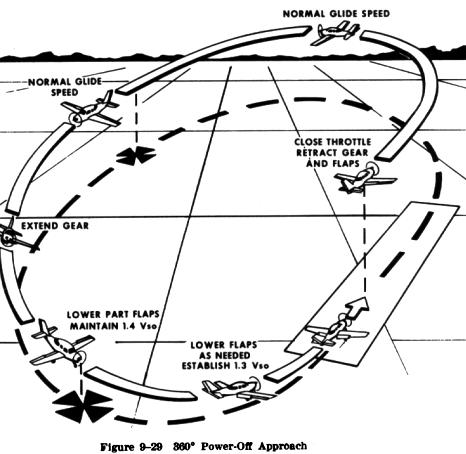| 360 Degree Power Off Approach
This advanced power off approach is one in which the airplane
glides through a 360 degree change of direction to the preselected landing spot.
The entire pattern is designed to be circular but the turn may be shallowed,
steepened, or discontinued at any point to adjust the accuracy of the
flightpath.
| The 360 degree approach is started from a position over
the approach end of the landing runway or slightly to the side of it, with
the airplane headed in the proposed landing direction and the landing gear
and flaps retracted (Fig. 9-29).
It is usually initiated from approximately 2,000 feet or
more above the ground - where the wind may vary significantly from that at
lower altitudes. This must be taken into account when maneuvering the
airplane to a point from which a 90 degree or 180 degree power off
approach can be completed.
After the throttle is closed over the intended point of
landing, the proper glide speed should immediately be established, and a
medium banked turn made in the desired direction so as to arrive at the
downwind key position opposite the intended landing spot. At or just
beyond the downwind key position, the landing gear should be extended if
the airplane is equipped with retractable gear. The altitude at the
downwind key position should be approximately 1,000 to 1,200 feet above
the ground. |
|
After reaching that point, the turn should be continued to
arrive at a base leg key position, at an altitude of about 800 feet above the
terrain. Flaps may be used at this position, as necessary, but full flaps should
not be used until established on the final approach.
The angle of bank can be varied as needed throughout the pattern
to correct for wind conditions and to align the airplane with the final
approach. The turn to final should be completed at a minimum altitude of 300
feet above the terrain.
 |
FAATest.com
- Aviation Library
Dauntless
Software hosts and maintains this library as a service to pilots
and aspiring pilots worldwide. Click
here for ways to show your appreciation for this service.
While much of this material comes from the FAA, parts of it are (c) Dauntless Software, all rights reserved. Webmasters: please
do not link directly to individual books in this library--rather,
please link to our main web page at www.dauntless-soft.com or
www.faatest.com. Thanks! |
|

